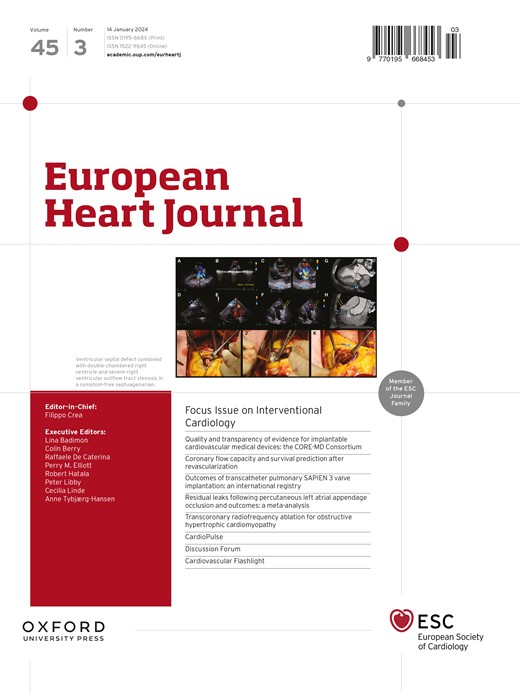秋水仙碱对血管事件的二级预防:试验荟萃分析
IF 37.6
1区 医学
Q1 CARDIAC & CARDIOVASCULAR SYSTEMS
引用次数: 0
摘要
背景和目的秋水仙碱二级预防动脉粥样硬化性心血管疾病的随机试验显示了不同的结果。方法采用系统评价和研究水平荟萃分析的随机对照试验,比较秋水仙碱与无秋水仙碱在二级预防动脉粥样硬化性心血管疾病人群中的作用。使用纳入试验的意向治疗人群应用固定效应反方差模型。主要结局是心血管死亡、心肌梗死或中风的组合。结果纳入9项试验,包括30659例已知冠状动脉疾病或卒中患者(秋水仙碱15255例,未秋水仙碱15404例)。与未服用秋水仙碱的患者相比,随机接受秋水仙碱治疗的患者的主要综合结局的相对危险度(RR)为0.88[95%可信区间(CI) 0.81-0.95, P = 0.002],包括心血管死亡的RR为0.94 (95% CI 0.78-1.13, P = 0.5),心肌梗死的RR为0.84 (95% CI 0.73-0.97, P = 0.016),卒中的RR为0.90 (95% CI 0.80-1.02, P = 0.09)。秋水仙碱与胃肠道事件住院相关的RR为1.35 (95% CI 1.10-1.66, P = 0.004),与肺炎、新诊断的癌症或非心血管死亡住院相关的RR为1.35。结论:在既往有冠状动脉疾病或卒中的患者中,秋水仙碱可使心血管死亡、心肌梗死或卒中的复合发生率降低12%。本文章由计算机程序翻译,如有差异,请以英文原文为准。
Colchicine for secondary prevention of vascular events: a meta-analysis of trials
Background and Aims Randomized trials of colchicine in secondary prevention of atherosclerotic cardiovascular disease have shown mixed results. Methods A systematic review and study-level meta-analysis of randomized controlled trials was performed comparing colchicine vs no colchicine in a secondary-prevention atherosclerotic cardiovascular disease population. A fixed-effect inverse variance model was applied using the intention-to-treat population from the included trials. The primary outcome was the composite of cardiovascular death, myocardial infarction, or stroke. Results Nine trials, including 30 659 patients (colchicine 15 255, no colchicine 15 404) with known coronary artery disease or stroke, were included. Compared with no colchicine, patients randomized to colchicine had a relative risk (RR) of 0.88 [95% confidence interval (CI) 0.81–0.95, P = .002] for the primary composite outcome, including a RR of 0.94 for cardiovascular death (95% CI 0.78–1.13, P = .5), a RR of 0.84 for myocardial infarction (95% CI 0.73–0.97, P = .016), and a RR of 0.90 for stroke (95% CI 0.80–1.02, P = .09). Colchicine was associated with a RR of 1.35 for hospitalization for gastrointestinal events (95% CI 1.10–1.66, P = .004) with no increase in hospitalization for pneumonia, newly diagnosed cancers, or non-cardiovascular death. Conclusions In patients with prior coronary disease or stroke, colchicine reduced the composite of cardiovascular death, myocardial infarction, or stroke by 12%.
求助全文
通过发布文献求助,成功后即可免费获取论文全文。
去求助
来源期刊

European Heart Journal
医学-心血管系统
CiteScore
39.30
自引率
6.90%
发文量
3942
审稿时长
1 months
期刊介绍:
The European Heart Journal is a renowned international journal that focuses on cardiovascular medicine. It is published weekly and is the official journal of the European Society of Cardiology. This peer-reviewed journal is committed to publishing high-quality clinical and scientific material pertaining to all aspects of cardiovascular medicine. It covers a diverse range of topics including research findings, technical evaluations, and reviews. Moreover, the journal serves as a platform for the exchange of information and discussions on various aspects of cardiovascular medicine, including educational matters.
In addition to original papers on cardiovascular medicine and surgery, the European Heart Journal also presents reviews, clinical perspectives, ESC Guidelines, and editorial articles that highlight recent advancements in cardiology. Additionally, the journal actively encourages readers to share their thoughts and opinions through correspondence.
 求助内容:
求助内容: 应助结果提醒方式:
应助结果提醒方式:


